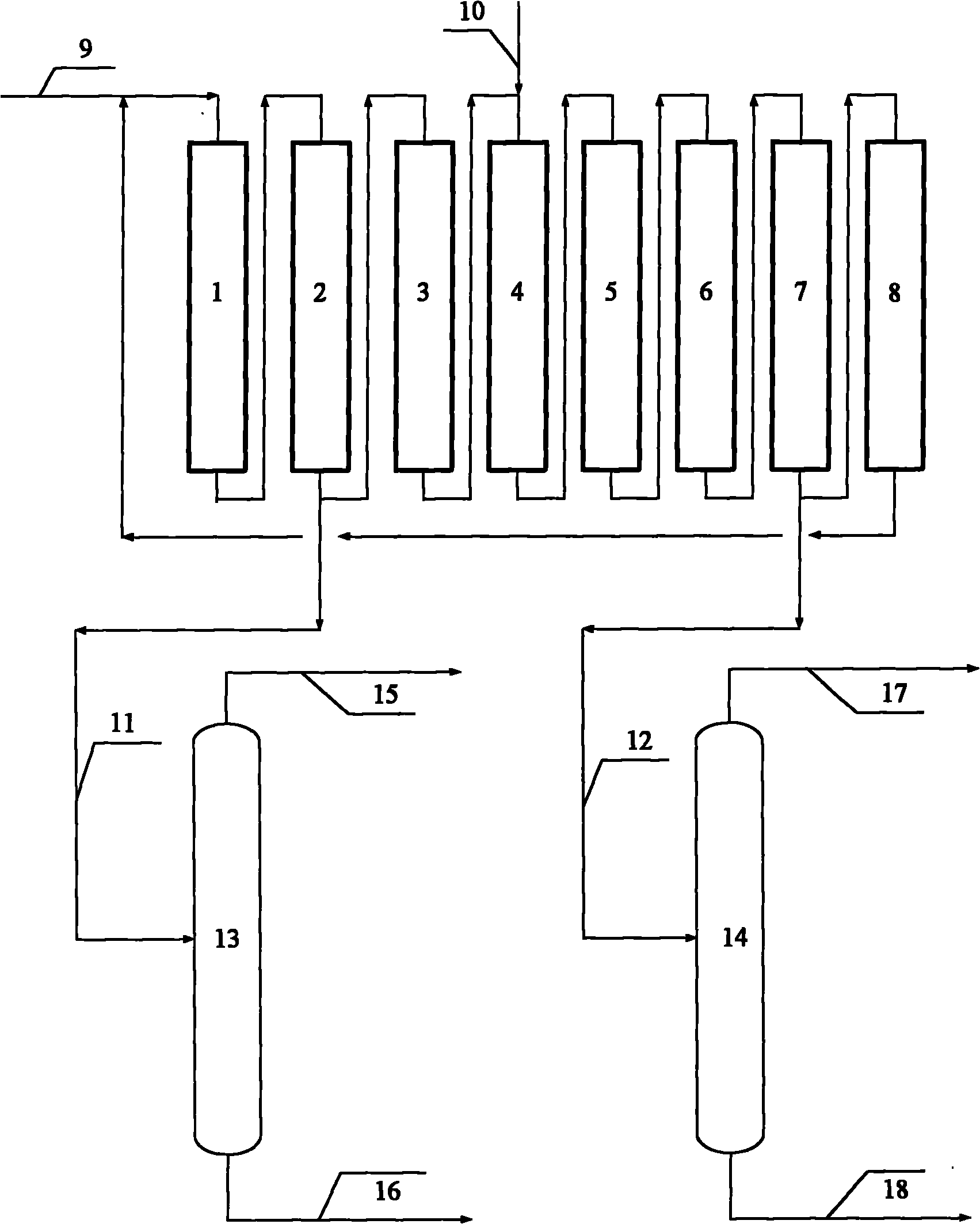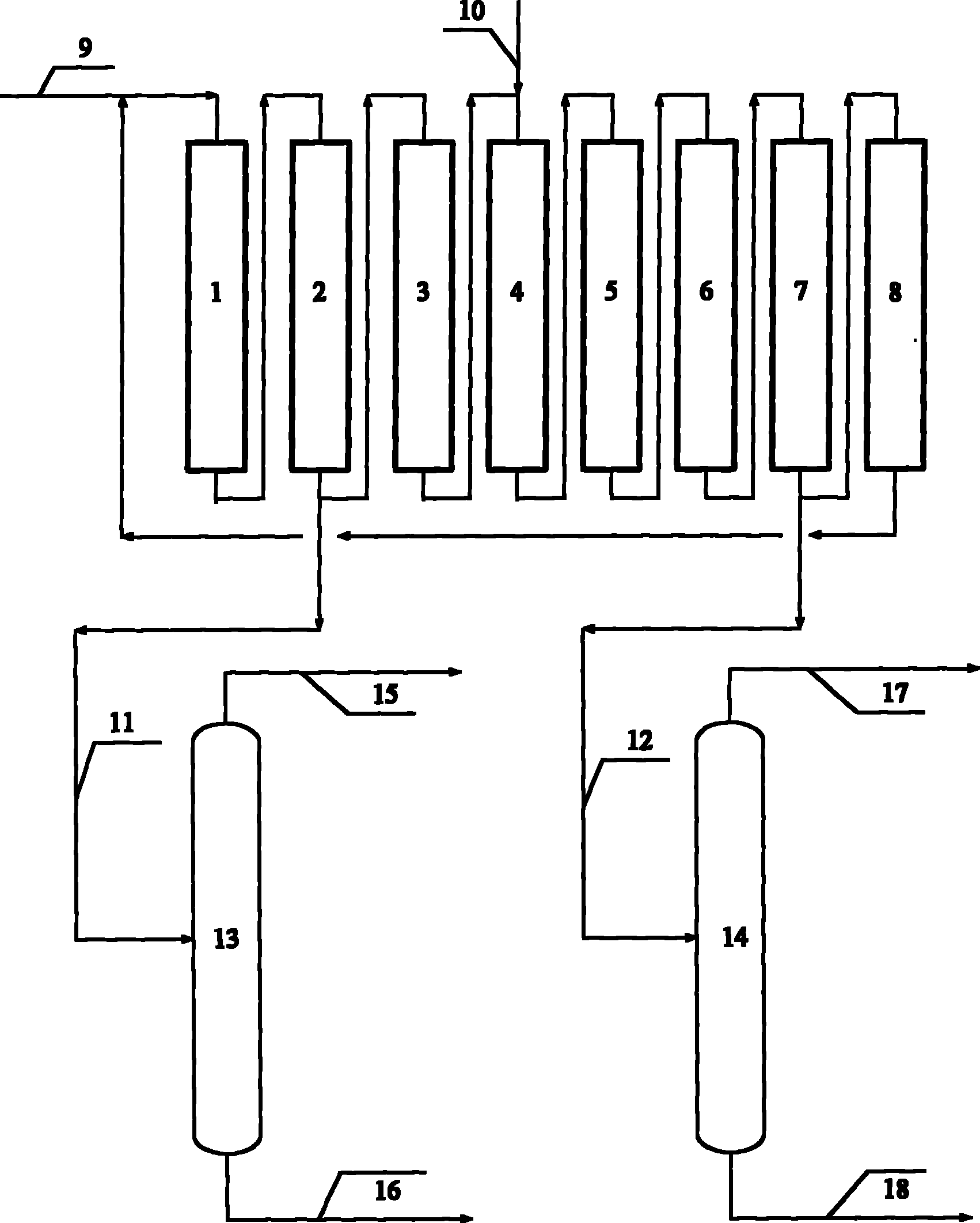Method for separating glycol and butylene glycol
A technology of butanediol and ethylene glycol, which is applied in the field of separation of ethylene glycol and butanediol, can solve the problem of high energy consumption of separation, and achieve the effect of low energy consumption of separation, good technical effect, and total energy saving
- Summary
- Abstract
- Description
- Claims
- Application Information
AI Technical Summary
Problems solved by technology
Method used
Image
Examples
Embodiment 1
[0014] according to figure 1 Shown flow process, methyl alcohol with 3.00 g / min and ethylene glycol, the mixture of 1,2-butanediol (the mass fraction of 1,2-butanediol is 15.00%) with 5.00 g / min respectively from bed layer number The 1st and 4th beds of the simulated moving bed are 8, filled with Suqing brand DA201-C resin, the operating pressure is normal pressure, the operating temperature is 40°C, and the space velocity is 1.5 hours -1 , the flow rate of the mixture of desorbent and 1,2-butanediol from bed 2 is 2.75 g / min, the flow rate of the mixture of desorbent and ethylene glycol from bed 7 is 5.25 g / min, extract and raffinate The liquid is separated by 1,2-butanediol separation tower and ethylene glycol separation tower respectively, and through ordinary distillation, the mass concentration of 1,2-butanediol is 99.95%, the mass concentration of ethylene glycol is 99.99% and the resolving agent is recovered The mass concentration is 100.00%, and the required distillati...
Embodiment 2
[0016] by similar figure 1 Shown flow process, water with 0.5 g / min and ethylene glycol, the mixture of 1,4-butanediol (the mass fraction of 1,4-butanediol is 1.00%) with 5.0 g / min respectively from bed layer The first and third beds of a simulated moving bed of 4 are filled with Suqing brand DA201-A resin, the operating pressure is 1MPa, the operating temperature is 20°C, and the space velocity is 0.2 hours -1 , the flow rate of the mixture of desorbent and 1,4-butanediol from bed 3 is 0.45 g / min, the flow rate of the mixture of desorbent and ethylene glycol from bed 4 is 5.05 g / min, and the extract and raffinate The liquid is separated by 1,4-butanediol separation tower and ethylene glycol separation tower respectively, and by ordinary distillation, the mass concentration of 1,4-butanediol is 98.15%, the mass concentration of ethylene glycol is 100.00%, and the resolving agent is recovered The mass concentration is 100.00%, and the required distillation energy consumption i...
Embodiment 3
[0018] by similar figure 1 Shown flow process, acetone with 10.00 g / min and ethylene glycol, the mixture of 1,3-butanediol (the mass fraction of 1,3-butanediol is 80.00%) with 5.00 g / min respectively from bed layer number The 1st and 14th beds of a simulated moving bed of 24 are filled with Suqing brand DA201-D resin, the operating pressure is 0.5MPa, the operating temperature is 50°C, and the space velocity is 5.0 hours-1, from the bed 6. Obtaining the flow rate of the mixture of resolving agent and 1,3-butanediol is 10.65 g / min, and the flow rate of the mixture of resolving agent and ethylene glycol obtained from bed 22 is 4.35 g / min. , 3-butanediol separation tower and ethylene glycol separation tower are separated, and through common distillation, obtain 1,3-butanediol mass concentration is 99.99%, ethylene glycol mass concentration is 99.99% and reclaims analytical agent mass concentration and is 100.00 %, the required distillation energy consumption is shown in Table 1....
PUM
 Login to View More
Login to View More Abstract
Description
Claims
Application Information
 Login to View More
Login to View More - R&D
- Intellectual Property
- Life Sciences
- Materials
- Tech Scout
- Unparalleled Data Quality
- Higher Quality Content
- 60% Fewer Hallucinations
Browse by: Latest US Patents, China's latest patents, Technical Efficacy Thesaurus, Application Domain, Technology Topic, Popular Technical Reports.
© 2025 PatSnap. All rights reserved.Legal|Privacy policy|Modern Slavery Act Transparency Statement|Sitemap|About US| Contact US: help@patsnap.com


